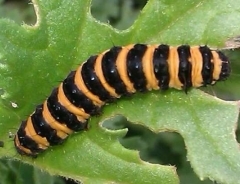
| Scientific classification | |
| Domain: | Eukaryota |
| Kingdom: | Animalia |
| Subkingdom: | Eumetazoa |
| Superphylum: | Ecdysozoa |
| Phylum: | Arthropoda |
| Subphylum: | Hexapoda |
| Class: | Insecta |
| Subclass: | Pterygota |
| Infraclass: | Neoptera |
| Superorder: | Panorpida |
| Order: | Lepidoptera |
| Suborder: | Glossata |
| Cohort: | Myoglossata |
| Subcohort: | Neolepidoptera |
| Infraorder: | Heteroneura |
| Superfamily: | Noctuoidea |
| Family: | Arctiidae |
| Subfamily: | Arctiinae |
| Tribe: | Arctiini |
| Subtribe: | Callimorphina |
| Genus: | Tyria |
Tyria jacobaeae is a brightly coloured arctiid moth, found in Europe and western and central Asia. It has been introduced into New Zealand, Australia and North America to control poisonous ragwort, on which its larvae feed. The moth is named after the red mineral cinnabar because of the red patches on its predominantly black wings. Cinnabar moths are about 20mm long and have a wingspan of 32–42 mm (1.3-1.7 in).
Like several other Arctiidae moth larvae, the cinnabar caterpillars can turn cannibalistic. Females lay up to 300 eggs, usually in clusters of 30 to 60. Initially, the larvae are pale yellow, but later larval stages develop the jet black and orange/yellow striped colouring. They can grow up to 30mm, and are voracious eaters; large populations can strip entire patches of ragwort clean, a result of their low predation.
Often, very few survive to the pupal stage, mainly due to them completely consuming the food source before reaching maturity; this could be a possible explanation for their tendency to engage in cannibalistic behaviour.
Common name(s): Cinnabar moth
Synonym(s): Phalaena jacobaeae, Noctua jacobaeae, Hippocrita jacobaeae f. confluens, Callimorpha senecionis, Euchelia jacobaea ab. flavescens
Like several other Arctiidae moth larvae, the cinnabar caterpillars can turn cannibalistic. Females lay up to 300 eggs, usually in clusters of 30 to 60. Initially, the larvae are pale yellow, but later larval stages develop the jet black and orange/yellow striped colouring. They can grow up to 30mm, and are voracious eaters; large populations can strip entire patches of ragwort clean, a result of their low predation.
Often, very few survive to the pupal stage, mainly due to them completely consuming the food source before reaching maturity; this could be a possible explanation for their tendency to engage in cannibalistic behaviour.
Common name(s): Cinnabar moth
Synonym(s): Phalaena jacobaeae, Noctua jacobaeae, Hippocrita jacobaeae f. confluens, Callimorpha senecionis, Euchelia jacobaea ab. flavescens
Sightings Heatmap
If you think any of the above information is incorrect, or would like to discuss this species, please use the comments box below.

 Tyria jacobaeae
Tyria jacobaeae





